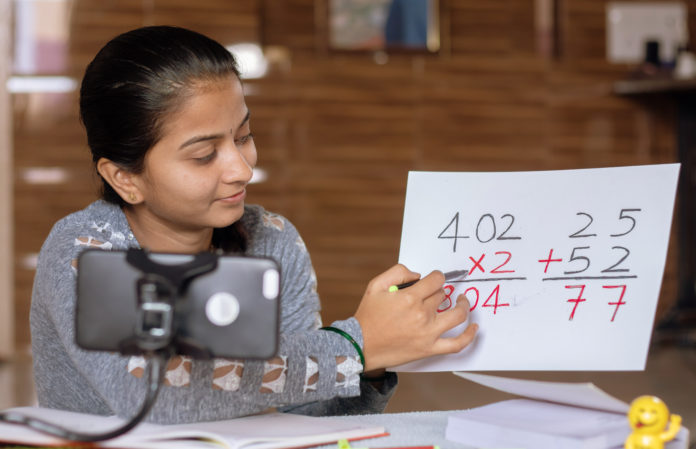School teachers in COVID-19 times have risen to the challenge of teaching online, and pack a lot into their new workday
Raji Monisha Cherian
Not since World War II have so many countries around the world seen schools and educational institutions shut down at the same time and for the same reason – the novel coronavirus.
The report card for the months of April, May and June would probably say, “No schools, no exams, and
online learning.”
It’s July now. Virtual academic sessions have already taken over the familiar teacher-student routine,
and the time-tested chalktalk teaching model. Managing the classrooms and the curricula outcomes, teachers across the country are multitasking: upgrading their digital skills and tackling their own quarantined families and responsibilities.
Balancing a dramatic change while they stay physically distanced from classrooms, teachers everywhere are working hard, long into the nights, and through weekends.
Committed to the central tenets of teaching – engagement and pedagogy, they have responded
to the emergency with alacrity.
As hidden heroes, they are working quietly on the frontlines tending to the well-being of their students.
Teachers are in mission-mode, and it is time we acknowledge their contribution.
Challenges
A typical day in the life of a teacher packs in a lot. And this goes beyond teaching fractions and
literature online. Online classes to post-COVID-19
classroom sessions, teachers across the country are handling multiple socio-economic, psychological
and learning delivery issues.
Kindergarten and primary classes: With their bouts of energy and movement curtailed and the structured learning atmosphere threatened, these children are meeting their teachers on the computer screen that’s part exciting and part unnerving.
Senior classes: Familiar with online sessions, these students have raised discipline and time management issues. If differing comprehension levels have made the delivery of certain subjects such as Chemistry difficult, reduced attention spans and the ability to mute exchanges online has made teaching stressful.
Special needs: Students with special needs have required additional academic support, given their levels of memory and retention power.
Socio-economic issues: Students from low-income groups have suffered hugely due to a lack of access to e-learning solutions. Some others have faced issues like lack of space and the need to share a single phone/ computer on a limited internet plan with their siblings. They need to be brought on par with the rest of the students with a little bit of extra effort when the institute reopens.
Emotional stress: The lockdown has exposed children at home to grave issues such as alcoholism
and domestic violence. Death of a family member due to COVID-19 has also contributed to their emotional stress.
Gender: Gender gaps have reared their ugly head during COVID the pandemic, questioning the education of the girl child.
Other issues: Absenteeism, extra duties and insufficient curricular materials have affected the
quality of education.
Caring beyond curriculum
The virus has not been kind to teachers. At the forefront of adapting to this change, they have acknowledged and accepted that there is nothing they can do about the situation and have developed the required mindset to overcome the anxiety and stress caused due to this extraordinary
predicament.
Rendering a service that has gone beyond their specified responsibilities, they have become
therapists, psychiatrists and counselors all rolled into one.
Despite extended and often underpaid working hours that sometimes go unappreciated and sometimes unattended, they have ensured that the classes are in full swing. From video lectures to feedback, tests and assignment submissions, this fraternity has been in action mode from Day One.
Their everyday agenda packs in a lot:
• Helping students get comfortable with online classes
• Obligatory meetings and training sessions
• E-mails, messages, and more from parents throughout the day
• Parent-teacher feedback sessions
• Management alerts
• Managing the constant barrage of links, passwords, Google classrooms and Zoom hangouts
The video call has put every student in the front row now. Armed with virtual resources, the teachers
are carrying education into every home and in the process have started contributing to a unified learning model, seamlessly integrating classroom learning with e-learning modes.
The current times are not easy for anyone. But the teachers have braved it all and continue to
channelise their energies to make learning exciting and meaningful.
With small doses of kindness and intentional teaching, they continue to connect in an effective and
efficient manner with every student helping them navigate through the pandemic.
Teachers across the nation have proven that it is possible to give technology a human face. It’s
time we salute these unsung warriors.
TEACHING RESOURCES RECOMMENDED BY UNESCO
https://www.schoology.com/
https://web.seesaw.me/
https://moodle.org/
GOVERNMENT OF INDIA INITIATIVE
https://diksha.gov.in/
Raji Monisha Cherian is a communications consultant, corporate trainer and a guest lecturer based in Chennai. She is a management professional and entrepreneur. You can reach her at rajimonisha@hotmail.com







